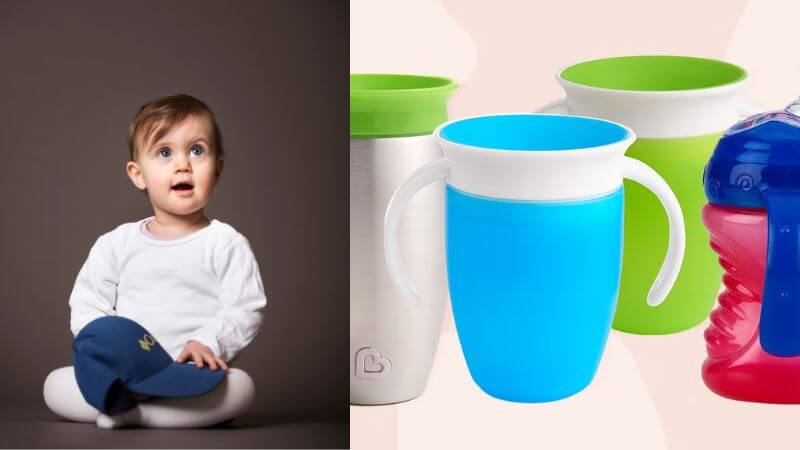Sippy cups for toddlers are an indispensable tool for parents transitioning their little ones from bottles to regular cups.
These handy drinking vessels help toddlers develop their motor skills, reduce spills, and make drinking easier.
In this article, we’ll explore the different types of sippy cups, the key features to look for, and tips for introducing them to your child.
Types of Sippy Cups for Toddlers
When shopping for these, you’ll come across various types, each designed with different needs in mind. Here’s a breakdown of the most common types:
- Spout Sippy Cups
These cups have a soft or hard spout, making it easy for toddlers to suck liquid without spilling. They are a great option for beginners. - Straw Sippy Cups
Equipped with a straw, these cups encourage more natural sipping and are often used for toddlers transitioning to regular cups. - 360-Degree Rim Cups
These cups allow toddlers to sip from any edge, mimicking the experience of drinking from a regular cup, but without the spills. - Trainer Sippy Cups
Trainer cups typically come with handles to make it easy for toddlers to grasp the cup. These are ideal for younger children who are just starting to use sippy cups. - No-Spill Sippy Cups
As the name suggests, these cups are designed to minimize or prevent leaks and spills, making them a favorite for on-the-go parents.
Key Features to Consider in Sippy Cups for Toddlers
With so many cups available, it’s important to know what to look for. Here are some key features to consider when choosing the best sippy cups for toddlers:
- Material: Sippy cups for toddlers are typically made of plastic, silicone, or stainless steel. Ensure that any plastic option is BPA-free for safety.
- Spill-proof: Toddlers are known for dropping things, so selecting a cup that prevents spills can save a lot of cleaning effort.
- Ease of Cleaning: A sippy cup with multiple parts can be challenging to clean. Look for dishwasher-safe models with fewer components.
- Handles: Some sippy cups come with handles, making it easier for toddlers to hold the cup independently.
- Size and Capacity: Make sure the sippy cup fits comfortably in your child’s hands and holds an appropriate amount of liquid for their age.
Benefits of Using These Cool Cups
Transitioning your child from a bottle to a cup offers several benefits. Here are a few reasons why sippy cups are a must-have for toddlers:
- Promotes Independence: Sippy cups help toddlers learn how to drink on their own without making a mess.
- Encourages Motor Skill Development: Holding and using a sippy cup improves a toddler’s hand-eye coordination and grip strength.
- Spill Prevention: Many sippy cups are designed to prevent leaks and spills, reducing the risk of messes.
- Supports Oral Development: Certain types of sippy cups, like straw and 360-degree cups, encourage healthy oral development by promoting natural sipping motions. Source
Tips for Introducing Sippy Cups to Toddlers
Introducing these cups to toddlers can sometimes be met with resistance, but with a little patience and persistence, your child will adapt. Here are some helpful tips:
- Start Early: Introduce the cups around 6-9 months to ease the transition from bottle or breastfeeding.
- Choose the Right Cup: Every toddler is different. Experiment with spout, straw, and 360-degree cups to see which one your child prefers.
- Demonstrate: Show your toddler how to drink from a sippy cup by using one yourself or encouraging them to mimic an older sibling.
- Use Favorite Drinks: Fill the cup with a drink your child enjoys to motivate them to use it.
- Be Patient: Transitioning takes time. Don’t get frustrated if your toddler doesn’t adapt immediately. Keep offering the cup consistently during meals and snack times. Source
Common Mistakes to Avoid When Using Sippy Cups for Toddlers
While these can be a game-changer for parents, there are a few common mistakes to watch out for:
- Using Sippy Cups Too Long: Prolonged use of the cups, especially those with spouts, can impact oral development. Switch to regular cups as soon as your child is ready.
- Not Cleaning the Cup Thoroughly: Due to their design, sippy cups can harbor bacteria if not cleaned properly. Make sure to disassemble and clean all parts regularly.
- Allowing Sippy Cups at Bedtime: Letting your child take a sippy cup to bed can increase the risk of tooth decay, especially if the cup contains milk or juice.
Summary!
Sippy cups for toddlers are an essential tool in helping your little one transition from bottles to regular cups.
With a wide variety of options available, it’s important to choose a cup that fits your child’s needs and stage of development.
Remember to consider key features like spill prevention, material, and ease of cleaning, while also encouraging your toddler to use the cup independently.
Hope you liked this article!
Also Read: Top 80 Cloud Puns, Quotes, Sayings And More!
Tinydale is on YouTube, Click here to subscribe for the latest videos and updates.
Follow Us: Facebook | Instagram | Twitter | Youtube | Pinterest

